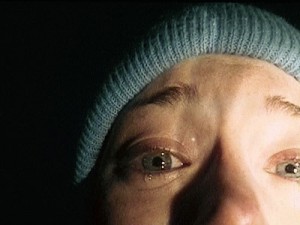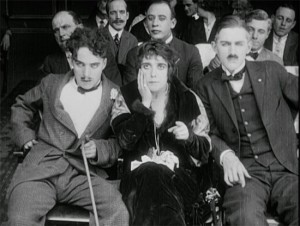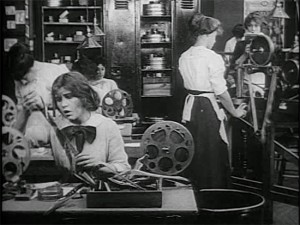Paranormal Activity and the Roots of Faked Footage
The horror movie franchise is just the latest in a long history of movies using so-called “recovered” films
/https://tf-cmsv2-smithsonianmag-media.s3.amazonaws.com/filer/20111102100023Paranormal-Activity-3_thumb.jpg)
Industry expectations were not high for the first Paranormal Activity, released back in 2009, in part because it was filmed for $10,000 in director Oren Peli’s home. (The premise behind the film is simple: a video camera records what happens when a troubled couple goes to sleep at night.) When the independent production was purchased by Paramount Pictures, it had been screened a handful of times. Paramount ordered a new ending before giving the film a limited opening in 13 cities in September, 2009.
Paramount tied the film’s national release to hits on eventful.com, one of the early instances of using social media to promote a motion picture. Even so, executives were surprised when Paranormal Activity outperformed such established horror entries as Saw IV at the box office. Two additional Paranormal Activity films have been released, one in 2010, the other this past October. Each has garnered better reviews and high box-office returns, guaranteeing further episodes. Imitators have popped up as well, like Cloverfield, which documents an alien monster attacking Manhattan, and the critically reviled Apollo 18, which used fake video surveillance footage to explain what happened to a doomed spaceflight.
The immediate inspiration behind Paranormal Activity was The Blair Witch Project (1999), a horror movie built around “recovered footage” shot by student filmmakers who were subsequently murdered. The genius behind Blair Witch was the filmmakers’ decision to make their lack of funding and experience part of the narrative, and not an obstacle to overcome. Blair Witch pretended that its out-of-focus shots, uneven lighting, shaky camera, ugly framing, and distorted sound were unedited, unembellished “reality,” and not Hollywood artifice. In the film’s logic, the footage in Blair Witch had to be “real” precisely because it was such poor quality.
That’s actually a trick filmmakers learned decades ago. When journalists are investigating Charles Foster Kane’s life in Citizen Kane, for example, they screen newsreels about the newspaper magnate. Director Orson Welles and his crew based this fake newsreel footage on The March of Time, using different film stock and cameras to capture its look. Stanley Kubrick did the same thing in Dr. Strangelove or: How I Learned to Stop Worrying and Love the Bomb, using a hand-held camera to imitate combat footage for scenes in which a military base is attacked. In Peeping Tom, the film that destroyed director Michael Powell’s career, the camera itself is a murder weapon, and the footage we see from it documents the filmmaker’s crimes.
The term “recovered footage” works better with these films than “found footage.” To my mind, “found footage” should refer to titles like Joseph Cornell’s Rose Hobart (1936) or Bruce Conner’s A Movie (1958), in which artists have repurposed material taken from other movies. It’s an interesting genre that deserves its own posting.
Some historians used to refer to “film within a film,” but this term became unwieldy once it became clear how frequently movies showed people watching other movies. Take Tillie’s Punctured Romance (1914), for example, cited as the first feature-length comedy. In it, Charlie Chaplin and Mabel Normand attend a screening of A Thief’s Fate, where they learn what to expect from a crime they committed earlier. Buster Keaton may have come up with the most creative example of a film within a film: in Sherlock Jr. (1924), he plays a projectionist who enters into the film he is showing. Woody Allen “borrowed” this idea for The Purple Rose of Cairo (1985), but it was a frequent ploy of animators as well. Both Bugs Bunny and Popeye on occasion would appeal to their audience for help during difficult situations. And in the delightful Porky’s Preview (1941), Porky screens his own cartoon to a barnyard audience. Primitive stick figures, bare landscapes, mistimed music, scratched-out drawings, wretched animation: it’s the same narrative strategy as Blair Witch, only funnier.
Closer to the theme of Paranormal Activity, in The Evidence of the Film (1913) an editor examines dailies from a movie shoot to solve a crime. A similar ploy is used by Michelangelo Antonioni in Blow-Up (1966) and Brian De Palma in Blow Out (1981)—and, for that matter, seemingly every other episode from television forensics series, from CSI: Crime Scene Investigation to Bones. The modern thriller could barely exist without surveillance monitors. The Bourne trilogy, Enemy of the State, Vantage Point, all resort to video footage for plot twists. Oren Peli’s smartest decision in Paranormal Activity may have been to strip away all the elements other filmmakers feel are so important: stars, special effects, production values, and plot.
/https://tf-cmsv2-smithsonianmag-media.s3.amazonaws.com/accounts/headshot/daniel-eagan-240.jpg)



/https://tf-cmsv2-smithsonianmag-media.s3.amazonaws.com/accounts/headshot/daniel-eagan-240.jpg)